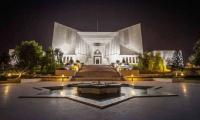LAHORE: A trip around Miranshah with an escort of heavily armed soldiers is a surreal experience. The town is the administrative centre of the northern half of Waziristan, a lawless region once controlled by jihadists that Barack Obama called “the most dangerous place in the world.”
But, reports the UK weekly The Economist, Pakistan’s army, which fought a 22-month campaign from 2014 to evict militants from North Waziristan, is trying to transform the town from a byword for extremism into a showcase of the stability to which the generals say the country is returning.
The army lost nearly 500 men in the fighting. About 3,400 militants were killed; many more fled across the border to Afghanistan. Signs of the violence are everywhere. But so too are efforts to provide greater prosperity for traumatised civilians (nearly 1m people living in the region were displaced). New roads fan out from the town. Lots of buildings, including shops, clinics and a sports stadium, are going up. A children’s playground has been laid out next to the river that flows through the town, dotted with Disneyfied fake cows.
There are ambitious plans for development elsewhere in North Waziristan. The army wants to build schools and bring water and electricity to neglected villages. It even talks of tourism. But the forts dotted across the barren hills are a reminder that security is more tenuous outside Miran Shah than the briefing given by the army in an underground bunker suggests. Indeed, a rocket attack on an army vehicle just a few miles away on the day of your correspondent’s visit killed two soldiers and injured three more.
The number of civilians killed by jihadists in the Federally Administered Tribal Areas (FATA), which includes North Waziristan, rose from 86 in 2016 to 138 last year, according to the FATA Research Centre, an independent think-tank. North Waziristan has remained fairly quiet, but the neighbouring district, Kurram, accounted for 76% of casualties, suggesting that some of the fighters ejected from North Waziristan are still uncomfortably close by.
Among those now holed up in Kurram is the Haqqani network, an ally of the Afghan Taliban that America says the Pakistani army is shielding. In his first tweet of 2018, Donald Trump accused Pakistan of “lies and deceit”. He later suspended $2bn in military aid. An American drone strike in North Waziristan last month reportedly killed a Haqqani commander and two of his accomplices. It came just a day after a deadly attack on a hotel in Kabul that Afghan officials claimed was carried out by the Haqqanis.
As part of a new campaign launched last year, it has stepped up its counter-terrorism efforts across FATA. In 2017 it carried out 164 “intelligence-led operations” targeting jihadists within the country, especially the Pakistani arm of the Taliban, the Tehreek-e-Taliban Pakistan (TTP).
The army’s pounding of the insurgents has had an effect. According to the South Asia Terrorism Portal, a website that monitors terrorism across the region, civilian deaths from extremist attacks in Pakistan have dropped from over 3,000 in 2013 to 540 last year. The figure is on track to fall again this year, with just 24 deaths so far.
Officials maintain that the majority of terrorist attacks in Pakistan now originate from Afghanistan, where the TTP and other groups have found a haven in the country’s “wild east”. Since the bulk of NATO forces left Afghanistan in 2014, border provinces such as Paktika, Khost, Nangarhar and Kunar (see map) have become largely ungoverned spaces from which jihadists can operate with relative impunity.
Nasser Janjua, a retired general who is national security adviser to Prime Minister Shahid Khaqan Abbasi, says he has evidence that 143 attacks in Pakistan have been organised by groups in Afghanistan. Mr Janjua accuses Indian and Afghan spooks of helping the TTP and Islamic State (IS), which is also active in Balochistan.
The army is seeking to reduce what it sees as the mayhem spreading across the border with Afghanistan by building a fence along all accessible parts of the 2,400km frontier.
Maj-Gen Asif Ghafoor, the army spokesman, says that the first phase, covering the most vulnerable 270 miles, should be completed by the end of the year and the rest of the $550m project a year after that. It will consist of two tall fences with barbed wire, about two metres apart. Pressure sensors and CCTV cameras will run along its length. There will be manned posts every mile or so and 443 forts along its course.
One potential beneficiary of the army’s campaign against domestic terrorism is the China-Pakistan Economic Corridor (CPEC). This is the Pakistani leg of China’s Belt and Road Initiative to revive Asia’s ancient trading routes.
China is investing over $60bn to upgrade Pakistan’s neglected infrastructure. New roads, railways, much-needed power stations and a deep-water commercial port at Gwadar in Balochistan are all part of the plan, which would link western China with the Arabian Sea. The projects could account for 20% of Pakistan’s GDP over the next five years and boost economic growth by three percentage points.
But it is hard to imagine China seeing the projects through, or other investors piling in, unless security can be improved. At either end of CPEC are two violence-prone regions: Azad Kashmir and Balochistan. Last year Baloch separatists killed ten labourers helping to build Gwadar port. There is talk of a Chinese-inspired scheme to install CCTV to monitor all the main roads that are part of CPEC.
Extending New Year greetings, Punjab CM prays for prosperous and happy year for Pakistan
IT ministry special secretary says that all online content is blocked only by shutting down internet
Project includes installation of 12,000 CCTV cameras with varying resolutions, for which 2,525 pole sites have been...
Musk offers no explanation about new username and avatar, but move triggered immediate ripple effects
1,177 people killed in 2024 included 488 civilians, 461 security forces personnel, and 225 terrorists
MWM chief says peace deal has been signed between rival tribes of Kurram after grand jirga was held in Kohat







